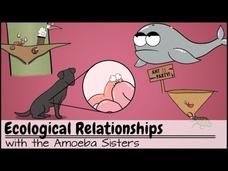Curated Video
Understanding Habitats, Niches, and Symbiotic Relationships in Ecology
This section covers the relationship between organisms and their environment. It also covers the Levels of Organization and symbiotic relationships.
msvgo
Population Interactions
Explain the different types of intraspecific and interspecific interactions among organisms with examples.
Visual Learning Systems
Viruses and Monerans: Bacterial Shapes and Activities
Practical examples show how viruses and bacteria are both beneficial and harmful to humans. Animations describe the structure of a virus, and explain how they reproduce and cause disease. Microscopic images illustrate different types and...
Be Smart
We've Got Ants in Our Plants!
Some ants are so aggressive, they can repel an elephant. Viewers learn this fact and more in an engaging video that is part of a larger playlist on biology. It discusses the relationships between ants and plants. While plants provide...
Bozeman Science
Populations
The largest concentration of free-roaming wildlife in the continental United States is found in Yellowstone National Park. A video describes the three main types of population interactions: mutualism, commensalism, and parasitism. It...
TED-Ed
You and Your Microbes
Humans are like planets, hosting a plethora of microbial communities. This concept is explored with vivid narration and animation, bringing to light the benefits of the huge variety of microbes that live in and on our bodies. What a fun...
Scholastic
Study Jams: Symbiosis
Three types of symbiosis are explained: parasitism, commensalism, and mutualism. This is done with colorful animation and lively dialogue in a straightforward and easy-to-follow manner. Have your ecology class watch this at home and then...
Curated OER
Populations
Every species in the world has some type of relationship with another species, whether it be positive, negative, or neutral for each party. Mr. Andersen defines each type of relationship and provides clear examples under each category....
Amoeba Sisters
Ecological Relationships
What are ecological relationships? Well, it can be complicated! Paint a clear picture for pupils with a fun and informative video. It explains and illustrates each relationship thoroughly, from pesky parasites to snuggly symbiotes.
Teacher's Pet
Species Interactions
Every species competes for food. The video explains interspecific competition, intraspecific competition, and the competitive exclusion principle as a part of predator-prey relationships. It also covers resource partitioning and the...
Deep Look
The Double-Crossing Ants to Whom Friendship Means Nothing
I'll scratch your back, if you'll scratch mine—unless someone else comes along that is a better scratcher! Examine the fickle nature of rainforest insects using a captivating video. The narrator describes the mutualistic relationship...
SciShow
How Plants Attract Bodyguards
Why would non-flowering leaves produce nectar? Plants adapted behaviors to recruit insects in order to protect themselves. Caterpillars might want to eat the tasty leaves, but not if ants attack them first. When caterpillars start eating...
SciShow
Human Parasites
You are an entire biome! A video explain the many parasites that inhabit your body. It begins with the good, beneficial bacteria and mutualism. Then it covers the symbiotic relationships and concludes with the bad ones.
Be Smart
How Bees Can See the Invisible
What do bees use to get rid of tangles? A honey-comb! The video focuses on how bees instinctively find flowers — their eyes view the world differently than ours. They also seem to be guided by electric charges because the bees have a...
Crash Course
Community Ecology: Feel the Love
Warblers are small birds that have been known to get caught in spider webs. The video covers community ecology, focusing on the Competitive Exclusion Principle using the example of warblers. It also includes fundamental versus realized...
PBS
Pbs Learning Media: Ancient Farmers of the Amazon
This video segment from Evolution: "Evolutionary Arms Race" tells the story of the leafcutter ant and the fungus it farms -- an example of mutually beneficial symbiosis. [4:59]
Sophia Learning
Sophia: Symbiotic Relationships: Lesson 3
This lesson will introduce the three types of symbiotic relationships and give examples of each. It is 3 of 4 in the series titled "Symbiotic Relationships."













